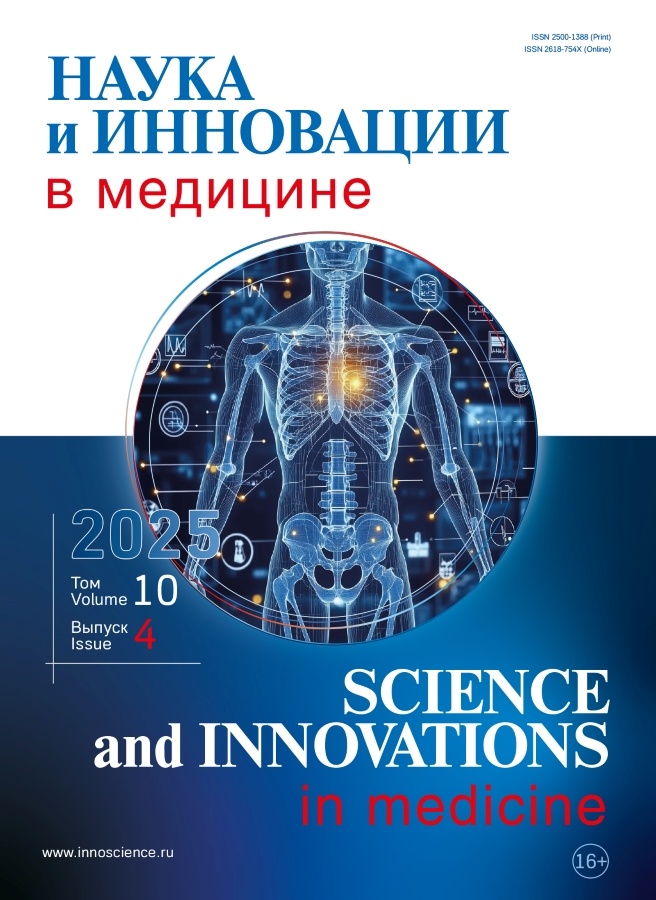Diagnostic potential for detecting upper limb arthropathy in ischemic stroke patients with RRS score of 4–6 points
- Authors: Chichanovskaya L.V.1, Bakhareva O.N.1, Ganza D.V.1, Menshikova T.V.1
-
Affiliations:
- Tver State Medical University
- Issue: Vol 10, No 4 (2025)
- Pages: 297-301
- Section: Neurology
- URL: https://journal-vniispk.ru/2500-1388/article/view/351299
- DOI: https://doi.org/10.35693/SIM678749
- ID: 351299
Cite item
Full Text
Abstract
Aim – to identify the features of the formation of upper limb arthropathy in patients with ischemic stroke with 4-6 points on the rehabilitation routing scale (RRS) depending on the type of treatment and rehabilitation procedures.
Material and methods. Ninety-eight patients with ischemic stroke were examined in two periods: Period 1, 13.2 ± 0.8 days and Period 2, 189.2 ± 2.1 days. Ultrasound and X-ray examinations were performed to determine the nature of damage to the joint complex of the upper limb. The severity of the neurosomatic status was assessed using the NIHSS, MRS, MMSE, VAS, and RRS scales.
Results. Post-stroke hemiparesis in the acute period of ischemic stroke was registered in 86 patients (88%), and upper limb arthropathy in 36 (37%) of the examined patients. In 12 (32%) patients with ischemic stroke the arthropathy of the shoulder joint combined with damage to other joints. In the majority of patients with ischemic stroke with arthropathy, according to the ultrasound data of the joints, synovitis was detected in 27 (76%), and tendon tendinitis in 17 (47%) that form the structure of the shoulder joint. In dynamics, contracture of the upper limb was revealed in 12 (26%) of the examined and was combined with a more pronounced cognitive defect, which required development of preventive and corrective methods.
Conclusion. It is proposed to introduce into the diagnostic standard of patients with ischemic stroke with paresis of 0-3 points ultrasound of the affected joint to identify early markers of arthropathy in order to promptly prevent contracture of the upper limb.
Full Text
##article.viewOnOriginalSite##About the authors
Lesya V. Chichanovskaya
Tver State Medical University
Email: nevrotver@mail.ru
ORCID iD: 0000-0002-3808-4866
MD, Dr. Sci. (Medicine), Professor, Head of the Department of Neurology, Rehabilitation and Neurosurgery
Russian Federation, TverOlga N. Bakhareva
Tver State Medical University
Author for correspondence.
Email: bakharevaon@tvgmu.ru
ORCID iD: 0000-0003-0442-4524
MD, Cand. Sci. (Medicine), Associate Professor of the Department of Neurology, Rehabilitation and Neurosurgery
Russian Federation, TverDenis V. Ganza
Tver State Medical University
Email: denisganzya@mail.ru
ORCID iD: 0000-0002-3376-6585
MD, Assistant of the Department of Neurology, Rehabilitation and Neurosurgery
Russian Federation, TverTatyana V. Menshikova
Tver State Medical University
Email: menshikovatv@tvgmu.ru
ORCID iD: 0000-0003-2645-3596
MD, Cand. Sci. (Medicine), Associate Professor of the Department of Neurology, Rehabilitation and Neurosurgery
Russian Federation, TverReferences
- Lyukmanov RKh, Rimkevichus AA, Gnedovskaya EV, Suponeva NA. Poststroke shoulder arthropathy. Effective Pharmacotherapy. 2023;19(3):52-58. [Люкманов Р.Х., Римкевичус А.А., Гнедовская Е.В., Супонева Н.А. Постинсультная плечевая артропатия. Эффективная фармакотерапия. 2023;19(3):52-58]. doi: 10.33978/2307-3586-2023-19-3-52-58
- Kozlova NS. Post-stroke periarthropathy of shoulder joint: epidemiology, pathogenesis, clinical performance, diagnostics, possible treatment options. Russian Osteopathic Journal. 2018;3-4:119-127. [Козлова Н.С. Постинсультная периартропатия плечевого сустава: эпидемиология, патогенез, клиническая картина, диагностика, возможные варианты лечения. Российский остеопатический журнал. 2018;3-4:119-127]. doi: 10.32885/2220-0975-2018-3-4-119-127
- Kalichman L, Ratmansky M. Underlying pathology and associated factors of hemiplegic shoulder pain. Am J Phys Med Rehabil. 2011;90(9):768-780. doi: 10.1097/PHM.0b013e318214e976
- Roosink M, Renzenbrink GJ, Buitenweg JR, et al. Somatosensory symptoms and signs and conditioned pain modulation in chronic post-stroke shoulder pain. The journal of pain. 2011;12(4):476-485. doi: 10.1016/j.jpain.2010.10.009
- Kotelnikova AV, Pogonchenkova IV, Titova AV, et al. Approbation of the Methodology “Scale for Cognitive Status Assessment of the After-Stroke Patients with Speech Disorders”. Bulletin of Rehabilitation Medicine. 2024;23(6):26-37. [Котельникова А.В., Погонченкова И.В., Титова А.В., и др. Апробация методики «Шкала оценки когнитивного статуса пациентов после перенесенного инсульта с учетом нарушений речи». Вестник восстановительной медицины. 2024;23(6):26-37]. doi: 10.38025/2078-1962-2024-23-6-26-37
- Kostenko EV, Petrova LV, Nahrapov DI, Pogonchenkova IV. Effect of rehabilitation interventions on poststroke upper limb dysfunction and cognitive functions: a systematic review and meta-analysis. Bulletin of Rehabilitation Medicine. 2023;22(1):69-79. [Костенко Е.В., Петрова Л.В., Нахрапов Д.И., Погонченкова И.В. Влияние реабилитационных вмешательств на постинсультную дисфункцию верхней конечности и когнитивные функции: систематический обзор и метаанализ. Вестник восстановительной медицины. 2023;22(1):69-79]. doi: 10.38025/2078-1962-2023-22-1-69-79
- Meyer S, Karttunen AH, Thijs V, et al. How do somatosensory deficits in the arm and hand relate to upper limb impairment, activity, and participation problems after stroke? A systematic review. Physical Therapy. 2014;94(9):1220-31. doi: 10.2522/ptj.20130271
- Munthe-Kaas R, Aam S, Ihle-Hansen H, et al. Impact of different methods defining post-stroke neurocognitive disorder: The Nor-COAST study. Alzheimers Dement. 2020;6:e12000. doi: 10.1002/trc2.12000
- Auriat AM, Ferris JK, Peters S, et al. The impact of covert lacunar infarcts and white matter Hyperintensities on cognitive and motor outcomes after stroke. Journal of Stroke & Cerebrovascular Diseases. 2019;28(2):381-388. doi: 10.1016/j.jstrokecerebrovasdis.2018.10.009
- Chhetri JK, Chan P, Vellas B, Cesari M. Motoric cognitive risk syndrome: predictor of dementia and age-related negative outcomes. Frontiers in Medicine. 2017;4:166. doi: 10.3389/fmed.2017.00166
- McDonnel M, Koblar S, Ward NS, et al. An investigation of cortical neuroplasticity following stroke in adults: is there evidence for a critical window for rehabilitation. BMC Neurology. 2015;15:109. doi: 10.1186/s12883-015-0356-7
- Hesseberg K, Tangen GG, Pripp AH, et al. Associations between Cognition and Hand Function in Older People Diagnosed with Mild Cognitive Impairment or Dementia. Dementia and Geriatric Cognitive Disorders Extra. 2020;10:195-204. doi: 10.1159/000510382
- Han P, Zhang W, Kang L, et al. Clinical Evidence of Exercise Benefits for Stroke. Advances in Experimental Medicine and Biology. 2017;1000:131-151. doi: 10.1007/978-981-10-4304-8
- Taravati S, Capaci K, Uzumcugil H, Tanigor G. Evaluation of an upper limb robotic rehabilitation program on motor functions, quality of life, cognition, and emotional status in patients with stroke: a randomized controlled study. Neurological Sciences. 2022;43(2):1177-1188. doi: 10.1007/s10072-021-05431-8
- Park J, Lee SU, Jung SH. Prediction of post-stroke functional mobility from the initial assessment of cognitive function. NeuroRehabilitation. 2017;41(1):169-177. doi: 10.3233/NRE-171469
- Grishina DA, Zakharov VV. Stroke and cognitive impairment. Effective Pharmacotherapy. 2019;15(19):16-23. [Гришина Д.А., Захаров В.В. Инсульт и когнитивные нарушения. Эффективная фармакотерапия. 2019;15(19):16-23]. doi: 10.33978/2307-3586-2019-15-19-16-23
Supplementary files









